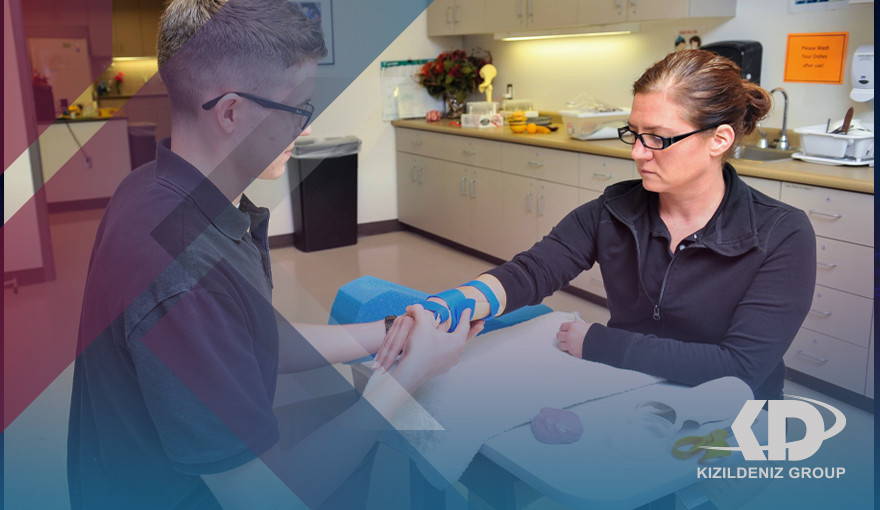What is the specialty of Occupational Therapy:
Occupational therapy (OT) is a profession in the healthcare field. It is the use of assessment and intervention to develop, restore, or maintain activities or professions that are meaningful to individuals, groups, or societies. It is an associated health profession performed by occupational therapists and occupational therapy assistants (OTA). OTs often work with people who have mental health issues, disabilities, injuries, or disabilities.
The American Occupational Therapy Association defines an occupational therapist as someone who “helps people throughout their lives to participate in the things they want and need to do through the therapeutic use of daily activities (occupations). Common occupational therapy interventions include helping children with disabilities to participate fully in school and situations. social, post-traumatic rehabilitation, and support for older adults with physical and cognitive changes.”
Occupational therapists are usually professionals with a college education and must pass a licensing exam to practice. Occupational therapists often work closely with professionals in physical therapy, speech and language pathology, audiology, nursing, social work, psychology, medicine, and assistive technology.
History of occupational therapy specialization:
The earliest evidence of the use of occupations as a method of therapy can be found in antiquity. In c. 100 BC, the Greek physician Asclepiades humanely treated mentally ill patients using therapeutic baths, massages, aerobics, and music. Later, Roman Celsus prescribed music, travel, conversation, and exercises to his patients. However, by the Middle Ages, the use of these interventions with people with mental illness was rare, if not non-existent.
In 18th century Europe, revolutionaries such as Philippe Pinel and Johann Christian Riel reformed the hospital system. Instead of using metal chains and shackles, their establishments used rigorous work and leisure activities in the late eighteenth century. This was the era of moral therapy, which developed in Europe during the Enlightenment, where the roots of occupational therapy lie, and although it flourished in Europe, interest in the reform movement fluctuated in the United States throughout the nineteenth century. It re-emerged in the early decades of the 20th century as occupational therapy.
The Arts and Crafts movement that occurred between 1860 and 1910 also influenced occupational therapy. In the United States, a newly industrialized nation, arts and crafts associations emerged against the monotony and autonomy of work in lost factories. Arts and crafts have been used as a way to enhance learning by doing, provide a creative outlet, and serve as a way to avoid boredom during a long hospital stay.
Eleanor Clark Slagl (1870-1942) is considered the "mother" of occupational therapy. Slagle, who was a founding member of the National Association for the Promotion of Occupational Therapy (NSPOT), suggested habits training as a basic model for occupational therapy. Based on the philosophy that engaging in purposeful actions shapes a person's well-being, habit training focuses on creating structure and a balance between work, rest and leisure. Although Habit Training was initially developed to treat individuals with mental health conditions, its core principles are evident in modern treatment models that are used across a wide range of clients.
In 1915, Slagle opened the first occupational therapy training program, Henry B. Favill School of Professions, at Hull House in Chicago. Slagell went on to serve as president and secretary of the AOTA. In 1954, the AOTA established the Eleanor Clarke Slagle Lectureship in her honor. Each year, this award is given in recognition of an AOTA member who has "creatively contributed to the development of the profession's body of knowledge through research, education, or clinical practice."
The importance of studying the specialty of Occupational Therapy:
When we talk about patient education, we're really talking about effective communication. Patients tend to respond best when they feel that their doctors have taken the time to communicate clearly and honestly their instructions, expectations, and recommendations. Active listening is also important. Often the patient just wants to be heard. Ask yourself: Are my patients given a chance to share their feelings? their pain levels? Reflections on treatment?
In our experience, a continued focus on patient education has resulted in:
Improving adherence to exercise, diet, and medication guidelines
A better understanding of the patient's condition
More efficient communications
Realistic patient expectations, especially regarding schedules
Reducing fear or apprehension
Safer treatment environment
Increased satisfaction with the treatment plan, leading to more referrals
An open environment for discussing questions and concerns
The strongest relationships that are respectful and empowering
Improved outcomes in patient health and well-being
What better way to have positive attitudes towards your clinic than to implement treatment plans that improve the lives of your patients? When patients feel valued, able, and clear about what they need to do, they tend to have a better attitude toward treatment. This can help them avoid prolonging treatment by making avoidable mistakes at home.
Fields of work for the Occupational Therapy major:
- Hydrotherapy exercise.
- Assistive technology.
- Wading.
- Brain injury.
- Diabetic.
- Leadership and community mobility.
- Environmental modification.
- Feeding, eating and swallowing
Best Universities for Occupational Therapy in Turkey:
- Istanbul Fanarbahceh University
- Istanbul Atlas University
- Istanbul Gelisim University
 FR
FR AR
AR
 Next one
Next one